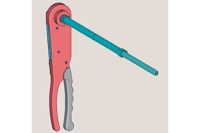In 2011, the U.S. Food and Drug Administration received more than 400,000 reports of adverse events related to medical devices. More than 12 percent of those events resulted in hospitalization.
When an adverse event occurs, the manufacturer is required to look into what went wrong. The FDA requires the manufacturer to report how it conducted the evaluation, the results of the investigation, and what conclusions it may have reached. However, the FDA does not provide guidance on how to conduct such evaluations.
Researchers at the Center for Advanced Life Cycle Engineering (CALCE) at the University of Maryland have recently developed a failure modes, mechanisms and effects analysis (FMMEA) method to help medical device manufacturers do just that. FMMEA is a systematic way to investigate failure mechanisms and generate device-specific reports to help manufacturers when preparing adverse-event evaluations for the FDA.
The new methodology builds on the traditional framework of failure modes and effects analysis (FMEA), which has been practiced since the 1950s. FMEA is a design tool to systematically analyze postulated component failures and identify the resultant effects on system operations.
A limitation of FMEA is that it does not always identify every failure mechanism, says Michael Pecht, Ph.D., director of the CALCE. For example, when FMEA was conducted on infusion pumps, the failure mechanisms for catheter leakage or breakage, such as fatigue, corrosion, kinking and chemical precipitation, were not identified.
FMMEA is a tool to support physics-of-failure-based design for reliability, says Pecht, a professor of mechanical engineering and applied mathematics at the university. It identifies and prioritizes the mechanisms for all potential failure modes. FMMEA can help medical device manufacturers develop reliable designs, plan tests to validate nominal design and manufacturing specifications, and determine limits on defects introduced by variability in manufacturing and materials. FMMEA enhances traditional FMEA methodologies by identifying high-priority failure mechanisms so engineers can take action to mitigate their effects.
FMMEA uses design information and the life cycle profile (LCP) of a product to identify critical failure mechanisms, says Pecht. An LCP is a forecast of the events and the environmental and usage conditions a product may experience from manufacture to end of life.
The device is divided into subassemblies for investigation. FMMEA should be conducted down to the lowest level for which the manufacturer still has design control. Analyses at lower levels should be performed by subassembly or component vendors.
In FMMEA, the potential failure modes for each failure site are listed, explains Pecht. A failure mode is the manner in which a failure is observed by methods such as visual inspection, electrical measurement, or other tests and measurements. For each failure mode, the potential causes are analyzed. A failure cause is the specific process, design or environmental condition that initiates a failure.
Possible failure causes are investigated for the entire life cycle of the device, including design, manufacture, operation and maintenance, says Pecht. For example, for a multilayer ceramic capacitor (MLCC), a component used in medical devices, the failure modes may be shorts, opens or parameter shifts, such as a decrease in insulation resistance or an increase in dissipation factor. The potential causes of these failures may be temperature and humidity conditions during storage or transportation.
Next, potential failure mechanisms are identified, says Pecht. Failure mechanisms are the processes by which a specific combination of physical, electrical, chemical, biological and mechanical stresses induces failures. For example, for an MLCC exposed to adverse temperature and humidity, failure mechanisms include metal migration between electrodes, dielectric degradation caused by moisture penetrating the voids, and creation of oxygen vacancies in the dielectric of the capacitor.
During the life cycle of a product, several failure mechanisms may be activated by different environmental and operational parameters acting at various stress levels. When conducting FMMEA, engineers should assess the combinations of occurrence and severity of each failure mechanism.



